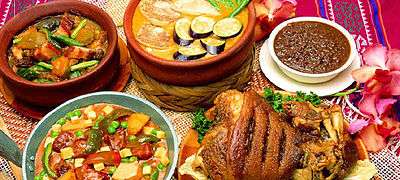Batchoy
Batchoy, less commonly spelled batsoy, is a noodle soup made with pork offal, crushed pork cracklings, chicken stock, beef loin and round noodles.[1][2] Its origins can be traced to the district of La Paz, Iloilo City in the Philippines, hence it is often referred to as La Paz Batchoy.
 A bowl of La Paz batchoy | |
| Alternative names | Ba-chui (Chinese) Batsoy (Tagalog) Báchoy (Spanish) |
|---|---|
| Course | Soup |
| Place of origin | Philippines |
| Region or state | La Paz, Iloilo City |
| Serving temperature | Hot |
| Main ingredients | noodles, pork organs, vegetables, chicken, shrimp, beef |
Origin
Batchoy's true origin is inconclusive. Documented accounts include the following:
- Inggo's Batchoy opened his Batchoy stall in 1922 and rumored to be the real first batchoy shop in La Paz Iloilo City, 16 years Ahead than Deco's La Paz Batchoy Shop, which opened in 1938
- The dish was concocted by Federico Guilergan Sr. in 1938 in Iloilo[3] His recipe called for a mixture of broth, noodles, beef and pork. The soup later evolved into its present form which has become Iloilo City's most popular dish. Federico Guillergan, Jr., the son of the soup's inventor, states that his father at first jokingly called the dish "bats" when asked for its name. Later, he added "choy", from the vegetable dish chop suey.[4]
- Teodorico Lepura opened his first batchoy shop at the La Paz public market in 1945. Run by Lepura, his wife and their children, the shop sold the original La Paz batchoy at that time priced at 20 centavos per bowl. In the 1930s, as a teenager, Lepura learned the basics of making La Paz batchoy while working for a Chinese merchant, and eventually concocted his own version of the dish.[1]
- Other sources state that the dish originated from the Chinese community in La Paz,[1][5] since the etymology of the name "Batchoy" likely comes from the Hokkien Chinese term (Chinese: 肉水; Pe̍h-ōe-jī: Bah-chúi), meaning meat soup.
Preparation
Ingredients include pork offal (liver, spleen, kidneys and heart) crushed pork cracklings, beef loin, shrimp broth, and round egg noodles or miki.
Oil is heated in a stock-pot. The pork organs, shrimp, chicken and beef are stir-fried for about a minute. Soy sauce is then added. The shrimp is then added and left to simmer for a few minutes. This broth is then added to a bowl of noodles and topped with leeks, pork cracklings (chicharon) and sometimes a raw egg is cracked on top.[6]
Eating
Most Filipinos eat the soup using spoon and fork. The soup is generally consumed first, the liquid broth rounds out the meal. Diners are encouraged to ask for a second, third, or even a fourth helping of kaldo (Hiligaynon, "broth").
See also
- Kinalas
- Cuisine of the Philippines
- Ginataan
- List of soups
- Soto - Indonesian soups, most of which made with chicken or beef.
- Ramen - a similar dish from Japan.
References
- Caligan, Michelle S. (2009-05-26). "The Ten Peso Wonder". EntrepreNews. Retrieved 2009-09-03.
- Besa, A.; Dorotan, R. (2014). Memories of Philippine Kitchens. Abrams. p. pt418. ISBN 978-1-61312-808-4. Retrieved August 24, 2018.
- Pendon, Lydia C. (2009-01-22). "Batchoy bowl draws thousands of children, adults". Sun.Star Iloilo. Archived from the original on 2009-05-12. Retrieved 2009-09-04.
- Burgos Jr., Nestor P. (2009-01-23). "Ilonggos feast on biggest bowl of La Paz batchoy". The News Today Online Edition. Retrieved 2009-08-05.
- Funtecha, Henry F. (2009-07-07). "Globalization and Philippine nationalism: Questions and options". The News Today Online Edition. Retrieved 2009-09-05.
- "La Paz Batchoy Recipe". Pinoy Recipe At Iba Pa. Retrieved 22 December 2018.

.jpg)